Early Heidelberg Line History
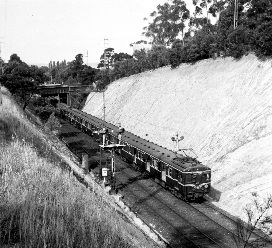
(Newspaper article sourced by Nilss.)
".........completing the railway line between the German-named hamlet and the metropolis."
"..........no fewer than 70 houses — all newly erected — have, or will have to be removed to make way for the Cockspur line."
"Some delay.......the contractors being unable to procure in the colony iron of the requisite size, and having to send for it to England."
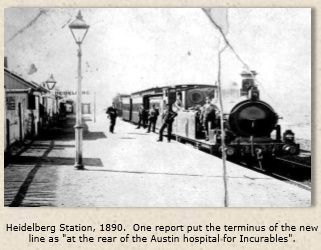
The former Inner circle line used to be called the "outer circle" in the 1880s. The former Outer circle line between Oakleigh and Fairfield Park was built in 1891.
The Age, 25.12.1886, Page 13
THE HEIDELBERG RAILWAY.
PROGRESS OF THE WORKS.
It is expected that within the next six months the beautiful village of Heidelberg with the picturesque surrounding country will be connected with Clifton Hill by rail, and thus a great stride made towards completing the railway line between the German-named hamlet and the metropolis.
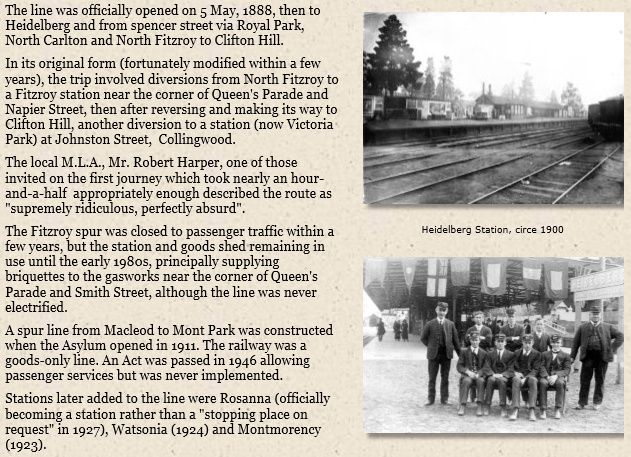
The first sod of the section of the line between the Royal Park, Clifton Hill and Johnston-street, was turned by the mayor of Collingwood on the 14th January last, but the contractors, Messrs. Horne and Flanagan were allowed two years within which to complete their contract; and therefore it is possible that the section of the Heidelberg line, between Alphington and Heidelberg, will be built before the line between Clifton Hill [and] Johnston-street is finished.
It may be remembered that about three years ago 2½ miles of the Heidelberg line — between Clifton Hill and Alphington — was completed.
This portion lay idle till January last, when the Government consented to a tramcar and gas motor being run upon the rails pending the opening of the line as a railway.
This conveyance runs in connection with the Collingwood omnibuses, and has proved of great convenience to persons travelling between Melbourne and Alphington. The speed of the car is sometimes greater than that of the cars propelled by cable.
Before proceeding to describe what is being done in connection with the Heidelberg to Alphington section of the Heidelberg and Melbourne railway it may be well briefly to give an idea of the scheme of which it forms a part.
Messrs. Horne and Flanagan are now engaged in the construction of the line known as the Royal Park to Clifton Hill line. Their contract consists of nine-tenths of a mile.
The same contractors have undertaken the construction of the line known as the Fitzroy "cockspur," which will run from the main or "outer circle" line at the north end of Brunswick-street through the Edinburgh Gardens to the Heidelberg-road.
This line will be a mile in length, and will terminate in a station occupying a site between Brunswick-street and Nicholson-street. The construction of the two pieces of work referred to has been let in one contract to Messrs. Horne and Flanagan, at the price of £49,000.
It is noteworthy that no fewer than 70 houses — all newly erected — have, or will have to be removed to make way for the Cockspur line.
The Royal Park to Clifton Hill line commences about 25 chains north of the present Royal Park station on the Melbourne and Coburg line with which it will form a junction. The Royal Park to Clifton Hill line will run under the Park-road and the Sydney-road, and the ordinary traffic will pass over bridges to be erected at those places.
This arrangement necessitates the making of a cutting 17 feet deep at the Sydney-road. This, however, will not be the deepest cutting. There will be another of equal depth to the west of the Plenty-road and one of 25 feet at the beginning of the line in the Royal Park.
The cutting in the Park-road cannot be proceeded with till a difficulty which has arisen between the Government and the Melbourne Corporation as to the position of the bridge shall have been settled. It appears that the Government has gazetted the road as a public one, but the Corporation has not yet taken it over.
The manner in which the ordinary traffic is to be diverted forms the immediate difficulty. There will be level crossings at the Plenty-road, Lygon-street, Park-street, Nicholson-street, Brunswick-street and St. George's-road. Rae-street will be blocked.
There will be stations at Nicholson-street; at Clifton Hill, near the Heidelberg-road, and at Johnston-street. The station ground of the last mentioned will extend from Johnston-street to Reilly-street.
An embankment 18 feet in height extends some distance between Clifton Hill and Johnston-street, and gradually dies away before the station ground at the latter place is reached.
Rosneath-street, which runs at right angles with Hoddle-street, between the latter and Clifton Hill will be crossed by an iron girder bridge upon brick piers.
The piers are now erected, and the girders will be placed shortly. Some delay has occurred in proceedingwith this work, in consequence of the contractors being unable to procure in the colony iron of the requisite size, and having to send for it to England.
So much for the Royal Park to Clifton Hill and the Fitzroy cockspur lines.
The Heidelberg to Clifton Hill line, with which we have now chiefly to do, will form a junction with the Royal Park to Clifton Hill line at the latter place. The 2½ miles already constructed was built by Messrs Noonan Brothers, the contract price being about £26,000.
This portion of the line terminates on the north, at the back of the Alphington Hotel, and 9 or 10 chains from the Darebin Creek. The continuation of the line between Alphington and Heidelberg is being constructed by Messrs. Ferguson and Blair, of Dunedin, New Zealand. The distance is 2½ miles, and the contract price, £47,000.
The Heidelberg line will be a single one, but in the construction of most of the bridges provision is being made for a duplication of the line if such should be at any future time necessary.
The largest bridge upon the line is that over the Darebin Creek at Alphington, consisting of six spans of 60 feet each. The piers of this bridge are now in course of construction. The highest pier is 50 feet from the ground surface, but the foundations are very deep. In one instance the foundation had to be carried 18 feet before the solid rock was found.
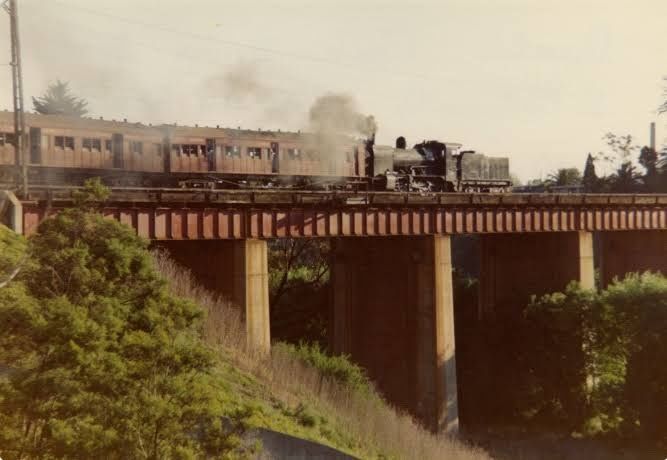
There are altogether six bridges on this section of the line. Besides the large one over the Darebin Creek there will be two bridges over the main road to Heidelberg, one at the Ivanhoe station ground and two accommodation bridges.
The last named are erected for the benefit of land owners whose land has suffered in an exceptional manner by sub-division for railway purposes. These two "accommodation bridges" will be constructed at "Rockbeare," and upon Mr. Wm. Smith's land near Heidelberg.
Under certain circumstances level crossings would be made for the accommodation of the owners of those lands, but as this was impracticable, bridges are to be constructed instead.
The deepest cutting upon the section is deep indeed. It is 45 feet in depth, and comprises 90,000 cubic yards. There are two or three other cuttings, but these are small in dimensions.
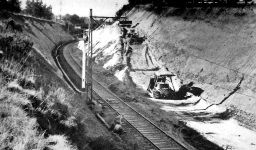
There are brick culverts of various sizes over the line, the largest being an arched culvert four feet by four feet, with a concrete bottom. No platelaying will be commenced till the bridges are completed.
It is expected that the great bridge over the Darebin Creek will be finished in about four months hence. The contractors are at present devoting most of their attention to earth works and bridges, but they are preparing for platelaying by getting sleepers, rails and other permanent way materials upon the ground.
Messrs. Ferguson and Blair have now been at work five months. Their contract time extends to December 1887, but they hope to have their work completed six months before that time.
A platform 400 feet long has been erected in the Ivanhoe station, and the contractors have just commenced one 300 feet long at the Heidelberg station.
A residence has also been erected at Alphington for the Government inspector of the works, which will be suitable hereafter for a gatekeeper's or stationmaster's house.
The piers of the bridge over the Darebin Creek, already alluded to, will be fine specimens of workmanship. They are being constructed of brick, with concrete foundations, and will be surmounted by enormous stones, called "bed stones," each weighing three tons. The iron girders of the bridge will rest upon, and be fastened to, these stones, which are being obtained from quarries at Brunswick.
To get the great stones to the top of the lofty piers will be an Herculean work. This will be effected by erecting a temporary staging at the [approach???] and using a strong derrick, with a 70 foot jib.
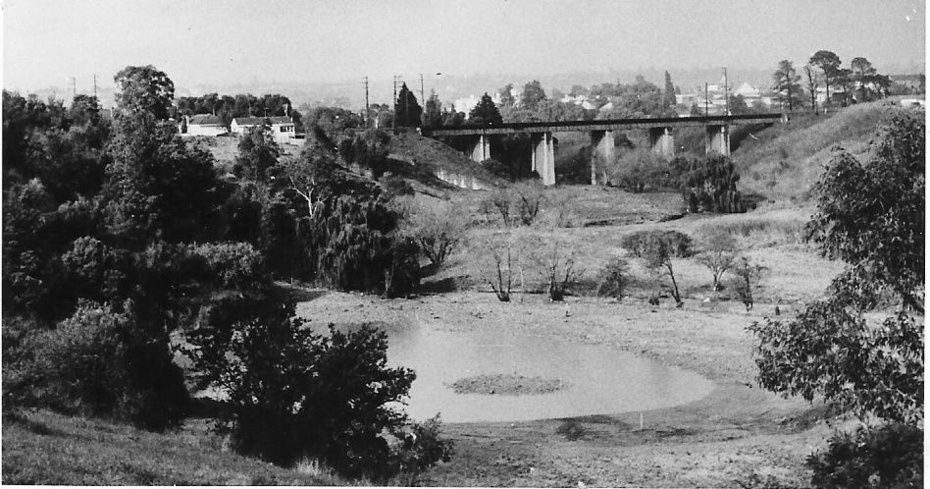
A cutting at Alphington has been found to be a very difficult one to work, in as much as it has had to be made almost entirely through bluestone, and blasting has had to be going on continually.
Several other cuttings have had to be made in this section of the line, but they have been very easily worked. About three-fourths of the earthworks in connection with the contract is now completed.
Sir Paton Jones is the resident engineer representing the Railway Commissioners, and Mr. Steele is the commissioner's inspector.
The connection of Heidelberg, Ivanhoe and Alphington with Melbourne by rail will, beyond all doubt, promote the prosperity of those northern suburbs in a most material way.
The scenery between Clifton Hill and Heidelberg at this season of the year is extremely picturesque, the green fields, dotted with pleasant villas and comfortable cottages, and slightly undulating hills lying in the distance, making up a landscape upon which the eye rests with delight.
The little valley of the Darebin at Alphington is as pleasant a spot as one could desire to fix his dwelling in, but, alas, it is more than probable that the steam engine will in time bear to this beautiful place so many settlers from the city that bricks and mortar will take the place of comely tree and verdant grass, and pleasant green lanes will be changed to stony and dusty streets.
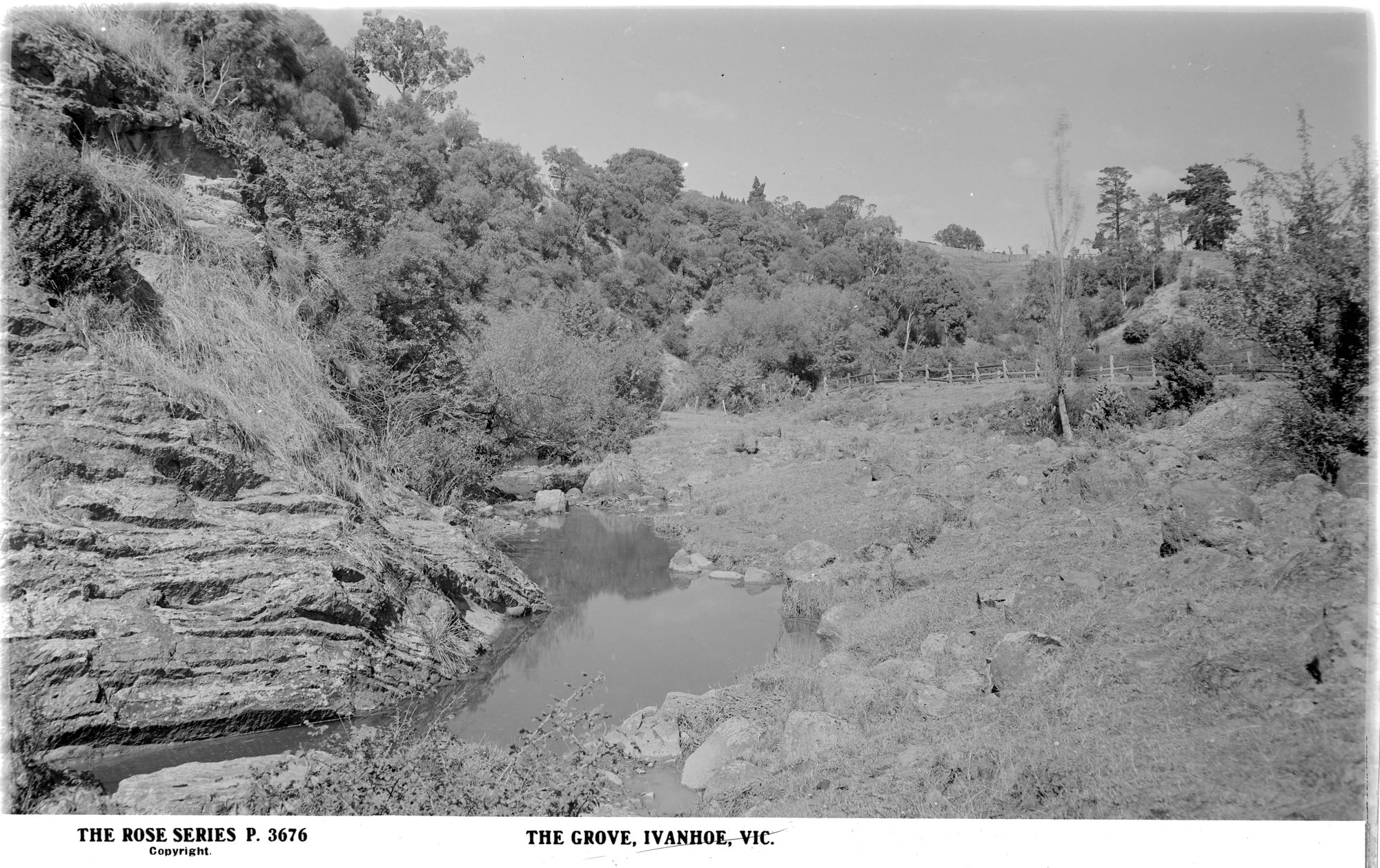
Member discussion